How Soft Corals Weaponize Their Symbiotic Algae

TL;DR: Termites perfected sustainable fungus farming 30 million years before humans existed. Through specialized labor and three-way cooperation with fungi and gut bacteria, they achieve 90% plant decomposition efficiency—a biochemical feat that still outperforms our industrial bioreactors.
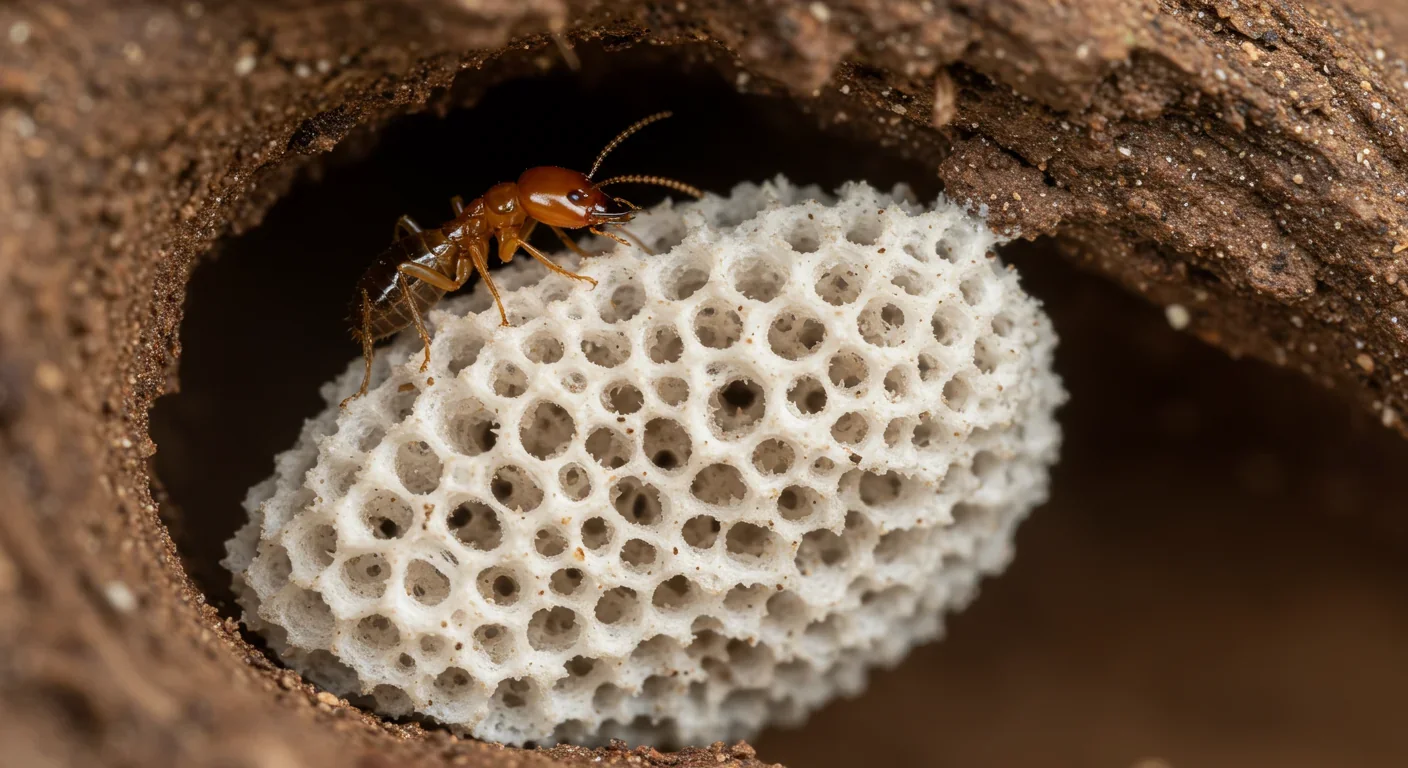
Thirty million years before the first humans planted seeds, termites in African rainforests had already perfected sustainable farming. While we're still figuring out how to break down plant waste efficiently in industrial bioreactors, these tiny insects solved the problem ages ago. Their secret? A partnership with fungus that's so sophisticated, it makes our agricultural revolution look like we just started yesterday.
The symbiosis between fungus-growing termites and Termitomyces mushrooms represents one of evolution's most successful experiments in cooperation. This isn't just an interesting quirk of nature—it's a complete agricultural system with specialized labor, monoculture farming, and near-perfect efficiency. And scientists are only now beginning to understand just how advanced it really is.
The evolutionary origins of termite farming trace back approximately 30 million years, shortly after the ancestor of Termitidae—the "higher" termites—acquired specialized gut symbionts. This marked a pivotal moment in insect evolution, when one subfamily, Macrotermitinae, took an unprecedented leap: they outsourced digestion entirely to an external fungal partner.
Unlike their termite cousins who rely solely on gut bacteria to digest cellulose, fungus-farming termites can't process plant material on their own. Species in the Macrotermitinae subfamily lost the ability to break down cellulose and lignin—the tough structural components of wood and plant matter. This evolutionary "deficiency" forced them into complete dependency on their fungal cultivars. But what looks like weakness became their superpower.
The partnership emerged from a single origin event in African rainforests and has since diversified into approximately 330 species of fungus-growing termites, each maintaining intricate relationships with Termitomyces, a genus of mushrooms found nowhere else in nature. This mutualism proved so successful that fungus-farming termites now dominate tropical ecosystems across Africa and Asia, decomposing up to 90% of all dead plant material in some regions.
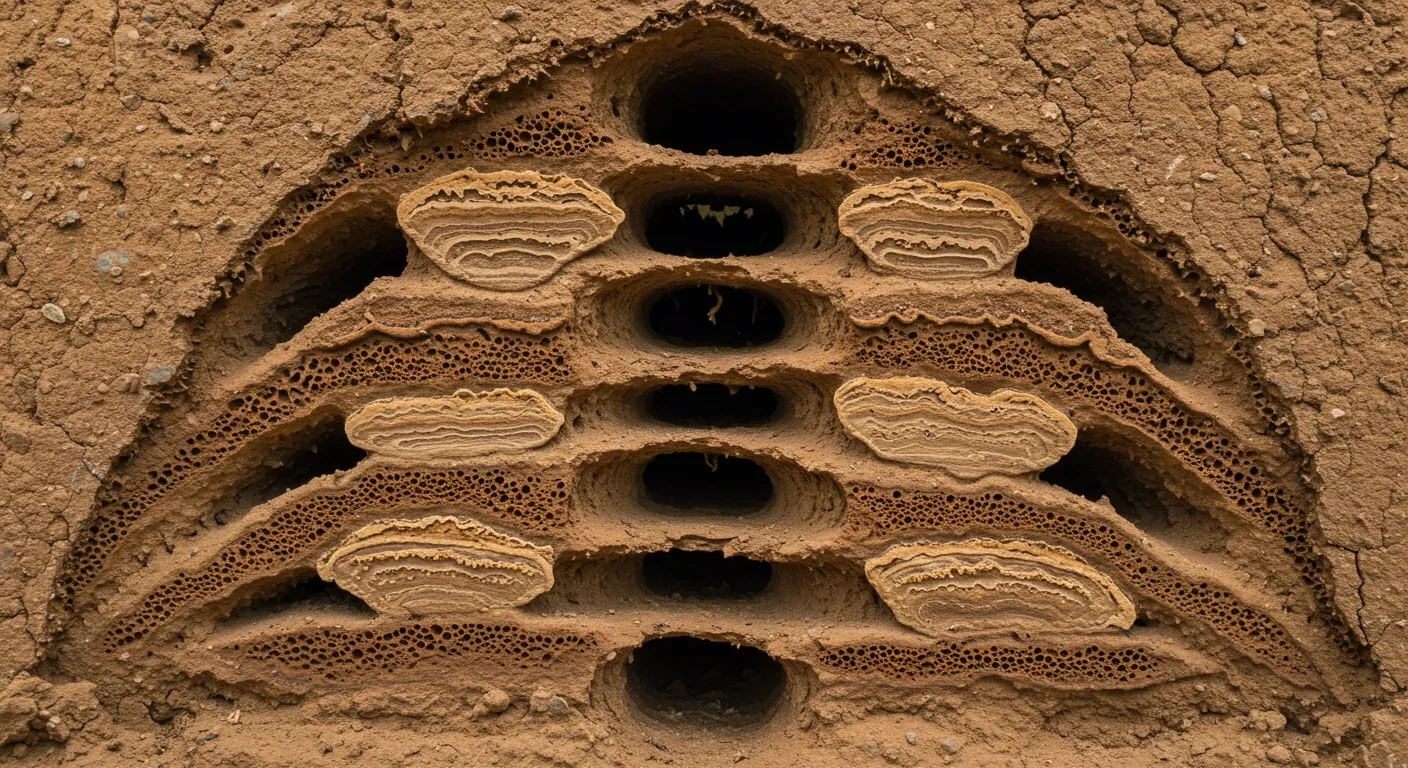
Walk into a termite mound and you'll find something that looks remarkably like a human farm—just underground and considerably older. The operation centers on structures called fungus combs or gardens, carefully ventilated chambers where the magic happens.
Here's the process: older worker termites venture out to collect dead plant material—dried grass, wood fragments, leaf litter. They haul these pieces back to the nest and begin chewing them into rough particles. But they don't digest this material. Instead, they pass it to younger workers who consume it along with Termitomyces spores that permeate the colony.
This spore-and-plant mixture travels through the younger workers' guts, getting inoculated with fungal spores during what researchers call the "first gut passage." The workers then defecate this mixture as a new layer onto the fungus comb. It's like seeding a field, termite style.
Termites achieve near-complete plant decomposition through intricate multi-stage cooperation between insects, fungi, and gut bacteria—a biological assembly line that has operated successfully for 30 million years.
The fungal mycelium takes over from there, spreading through the fresh layer and secreting powerful enzymes that break down cellulose and lignin—the compounds that make wood woody and grass tough. Over several weeks, the fungus converts this raw plant material into nutritious, easily digestible compounds. When the substrate is sufficiently processed, workers harvest and consume the fungus-enriched comb, extracting maximum nutritional value.
But the story doesn't end there. During this "second gut passage," bacteria in the workers' guts step in to complete the digestion, breaking down complex carbohydrates that even the fungus couldn't fully process. It's a three-way partnership: termites provide fresh plant material and physical infrastructure, fungus breaks down tough polymers, and gut bacteria handle the finishing touches.
One of the most puzzling aspects of termite agriculture is how they maintain genetic purity in their fungal crops. New colonies typically start when a queen receives multiple Termitomyces spores from different sources. Logic suggests these genetically distinct fungal strains would compete, creating a messy, inefficient garden. Yet research published in Science revealed that every mature colony contains only a single fungal genotype, despite being seeded with many.
Scientists discovered the mechanism behind this monoculture stability: when identical fungal mycelia encounter each other in the garden, they fuse together. This merging amplifies their growth and dramatically boosts production of asexual spores. Different genotypes can't merge, so they lose the competitive advantage. Over time, whichever genotype gets a head start in merging and reproduction dominates the entire garden, crowding out all competitors.
It's positive reinforcement at the cellular level—a biological winner-takes-all system that ensures every termite colony commits for life to a single fungal partner. This natural monoculture strategy solves one of agriculture's persistent challenges: how to maintain crop uniformity without constant intervention.
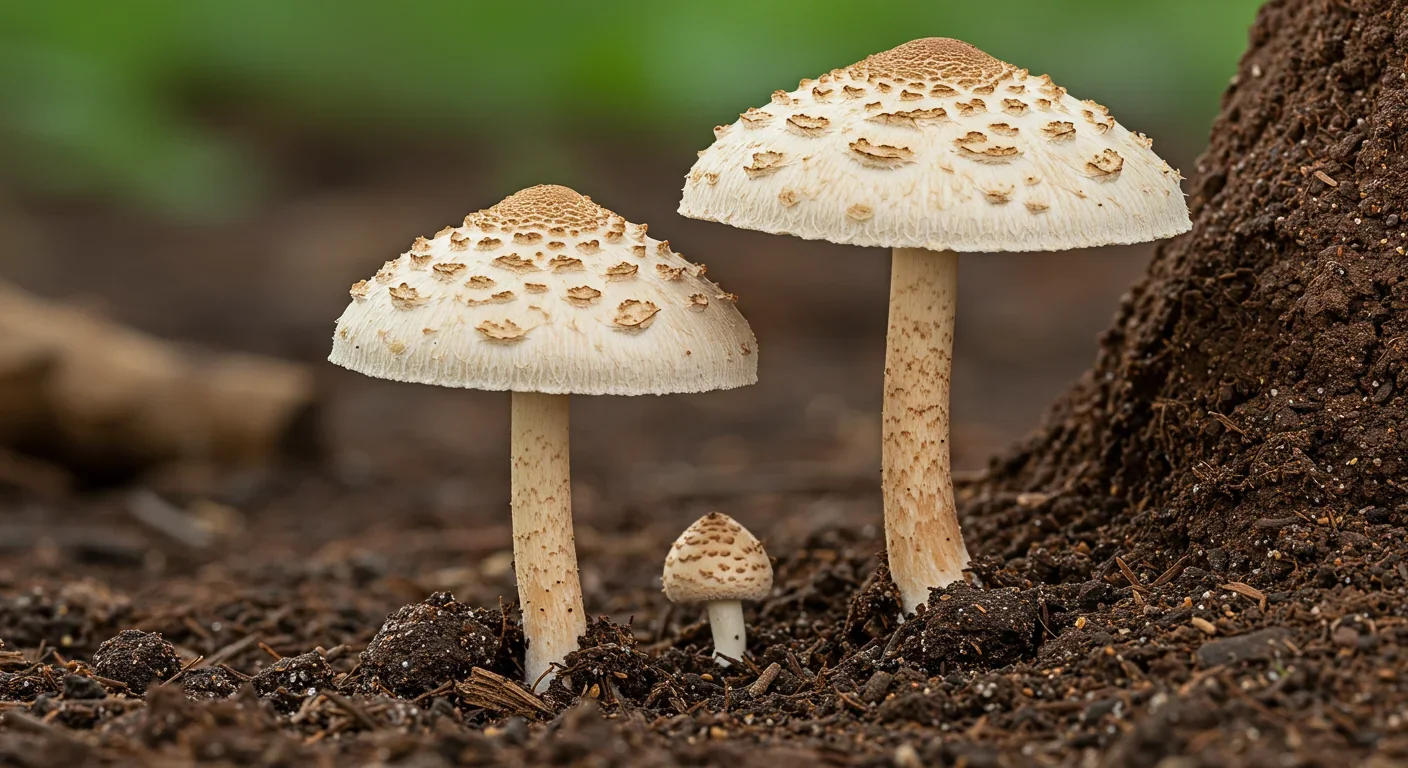
What makes this ancient agricultural system so effective? It comes down to biochemical diversity. When researchers at the University of Copenhagen sequenced the genomes of termites, Termitomyces fungi, and the gut bacteria involved, they uncovered something extraordinary: together, these organisms possess 86% of all known glycoside hydrolase enzyme families.
Glycoside hydrolases are the molecular scissors that snip apart complex plant sugars. No single organism—not humans, not bacteria, not even the most advanced fungi—comes close to this enzymatic breadth. It took the combined efforts of three kingdoms of life working in concert to achieve near-complete plant decomposition.
This division of labor is elegant: the fungus contributes enzymes specialized for breaking tough lignin bonds and attacking crystalline cellulose structures. The gut bacteria add enzymes that liberate simple sugars from the partially digested oligosaccharides. Each partner covers gaps in the others' capabilities, creating a biological assembly line with almost no waste.
"The great success of termite farmers as plant decomposers is due to division of labor between a fungus breaking down complex plant components and gut bacteria contributing enzymes for final digestion."
— Michael Poulsen, University of Copenhagen
The efficiency rivals anything humans have engineered. Industrial bioreactors, designed to convert plant biomass into biofuels, struggle to achieve complete breakdown of lignocellulosic material. We use heat, pressure, acid treatments, and cocktails of expensive enzymes—and still leave significant residues. Termites and their fungal partners do it at room temperature, at atmospheric pressure, using only the enzymes they naturally produce.
Just as human agriculture requires farmers, planters, and harvesters, termite farming involves specialized roles distributed across worker castes. But unlike human farmers who might switch between tasks, termites are locked into their roles by age and physiology.
Older workers, typically more heavily armored and experienced, serve as foragers. They leave the protected mound environment to scout for dead plant material, assess its quality, and transport it back home. These workers also perform the initial chewing and processing, reducing plant fragments to manageable pieces.
Younger workers remain inside the nest, where they receive the processed plant material from their older siblings. Their job is inoculation—consuming the plant matter mixed with fungal spores and defecating it as new garden substrate. Their gut chemistry is optimized for spore distribution rather than foraging or defense.
Interestingly, the queen and king—the colony's reproductive royalty—play no role in farming. Analysis of their gut microbiomes reveals drastically simplified bacterial communities that lack plant-decomposing enzymes entirely. They're fed pre-processed food by workers, freeing them to focus entirely on reproduction. This specialization mirrors how human societies evolved to support non-productive but reproductively crucial individuals.
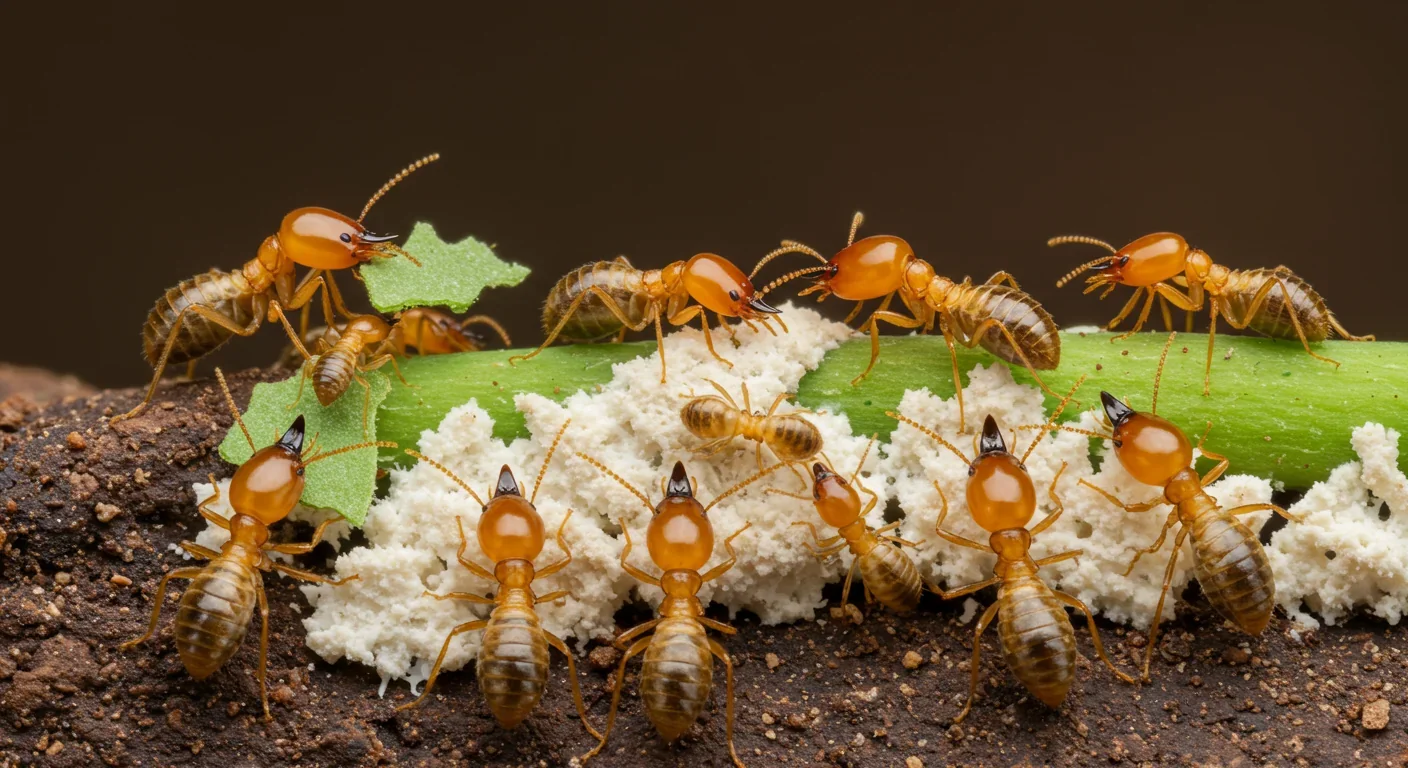
The parallels between termite farming and human agriculture are striking—and instructive.
Both systems rely on monoculture, cultivating a single crop species to maximize yield and predictability. Both involve domestication—Termitomyces mushrooms are found only in termite colonies, having evolved complete dependency on their insect partners, just as many of our crops can't survive without human cultivation.
Both use substrate preparation. Humans till soil and add fertilizers; termites chew plant matter and inoculate it with fungal spores. Both maintain controlled environments—termite mounds regulate temperature and humidity as carefully as any greenhouse.
Where the systems diverge is in genetic engineering. Humans have spent thousands of years selectively breeding crops for desired traits. Termites achieve similar results through fungal selection: they preferentially cultivate fungal strains that produce the most nutritious growth, effectively "breeding" their crops through behavioral choice rather than intentional crossing.
Perhaps most impressively, termite agriculture is completely sustainable. There's no soil depletion, no fertilizer runoff, no pesticide resistance. The system has run continuously for 30 million years without degrading the environments where it operates. In fact, termite farming enriches ecosystems by accelerating nutrient cycling and making locked-up plant energy available to other organisms.
Termite agriculture has operated sustainably for 30 million years. Human agriculture, just 10,000 years old, has already degraded a third of Earth's arable land.
Human agriculture, for all its sophistication, remains deeply unsustainable. We've been farming for roughly 10,000 years and have already degraded a third of Earth's arable land. The contrast is humbling.
In tropical African and Asian ecosystems, fungus-growing termites are the dominant decomposers, processing the vast majority of dead plant material. This isn't a minor ecological role—it's foundational.
Without these termites, dead leaves, fallen branches, and decaying grass would accumulate far faster than other decomposers could handle. Nutrients would remain locked in structural plant compounds, unavailable to new growth. The entire nutrient cycle would slow dramatically, reducing ecosystem productivity and resilience.
Termite mounds themselves become hotspots of biodiversity. The structures create microclimates, provide shelter for countless other species, and concentrate nutrients that support rich plant growth in the surrounding area. Some researchers estimate that termite activity increases local plant diversity and biomass significantly compared to termite-free areas.
There's also a climate angle. By rapidly converting dead plant material into CO₂ through respiration and methane through anaerobic decomposition, termites influence carbon cycling. Some scientists worry this makes them significant greenhouse gas contributors. Others argue they're simply accelerating processes that would happen anyway, and that the enhanced plant growth around their mounds captures more carbon than the termites release. The jury's still out, but the scale of their impact is undeniable.

The 2014 genome sequencing study represented a watershed moment in understanding termite agriculture. By analyzing the complete genetic blueprints of all three partners—termite, fungus, and gut bacteria—researchers revealed the precise molecular basis of their cooperation. They could identify exactly which enzymes each partner contributes and how these complementary capabilities evolved.
More recently, scientists have focused on symbiont specificity—how picky termites and fungi are about their partners. It turns out the answer varies by species. Macrotermes natalensis maintains strict fidelity to a single Termitomyces species, while Odontotermes species tolerate multiple fungal partners. This variability suggests different evolutionary strategies: some lineages prioritize optimization through tight co-evolution, while others favor flexibility and resilience.
The discovery of horizontal transmission of fungal spores between colonies was another game-changer. Originally, scientists assumed each colony's fungus was inherited vertically from the queen. But genetic analysis proved that Termitomyces fruiting bodies—the mushrooms that occasionally sprout from mounds—release spores that other colonies can acquire. This means termite agriculture isn't a closed system; there's genetic exchange happening at the fungal level, allowing beneficial mutations to spread across populations.
This finding has practical implications for pest control. If termites can simply acquire new fungal partners after their current crop is killed by fungicides, then targeting the fungus becomes much less effective. Researchers are exploring whether disrupting the symbiosis itself—rather than killing one partner—might offer better control strategies.
Beyond pure scientific curiosity, termite agriculture offers practical lessons for human technology and sustainability.
Biofuel production is one obvious application. The enzymes termites and Termitomyces use to break down lignocellulose are exactly what the biofuel industry needs to convert crop residues and wood waste into ethanol. Several companies are already investigating ways to mass-produce termite-derived enzymes or engineer microbes that mimic the fungus's capabilities.
Waste management is another frontier. If we could replicate the termite system at industrial scale, we could convert agricultural waste, yard trimmings, and even paper products into valuable nutrients or energy with minimal processing and no harsh chemicals. Some researchers envision "bio-refineries" that use termite-inspired enzyme cocktails to extract maximum value from organic waste streams.
"Achieving complete breakdown of plant biomass for energy conversion in industrialized bioreactors remains a complex challenge, but termite fungus farmers solved this problem more than 30 million years ago."
— Faculty of Science, University of Copenhagen
The organizational principles of termite colonies also inform robotics and swarm intelligence research. How do millions of individuals coordinate complex construction and farming without central control? The answer involves local interactions and simple rules that scale up to colony-level sophistication—principles that engineers are adapting for autonomous vehicle fleets, warehouse robots, and distributed sensor networks.
Perhaps most profoundly, termite agriculture demonstrates that complexity and "intelligence" can emerge without brains. No termite understands agriculture. No fungus has awareness of its role. Yet together they've maintained a system of exquisite sophistication for 30 million years. It's a reminder that evolution can solve problems we barely comprehend, and that nature's solutions often outperform our most advanced technologies.
Current research is pushing into new territories. Scientists want to understand the chemical signaling between termites and fungi—how do termites "tell" the fungus what to do, and how does the fungus "communicate" its nutritional status? These chemical conversations likely involve volatile compounds and surface proteins that researchers are only beginning to decode.
There's also interest in the evolutionary origins of the partnership. What were the intermediate steps between regular termites and committed farmers? Did early proto-farmers cultivate multiple fungi before specializing? How did the loss of cellulase enzymes in termite guts correlate with increased fungal dependency? Answering these questions requires fossil evidence and sophisticated phylogenetic analysis.
Another frontier involves climate change impacts. As temperatures rise and rainfall patterns shift, will termite agriculture adapt or collapse? Some models suggest termite populations could expand into currently temperate regions, while others predict that disrupted fungal life cycles might destabilize the symbiosis. The implications for ecosystem function are substantial.
Finally, researchers are investigating whether other insects might be coaxed into similar partnerships. Could we engineer agricultural systems based on termite principles, using different insects and fungi tailored to specific crops or regions? It's speculative, but the success of the termite model suggests the potential is there.
When we think about agriculture, we naturally center human achievement. We invented plows, irrigation, selective breeding, genetic modification. We transformed landscapes and built civilizations on farmed food. It feels uniquely human.
But termites remind us that we're not nearly as special as we think. They were farming when our ancestors were still living in trees. They achieved sustainability we've yet to match. They engineered three-way symbioses that outperform our best industrial processes.
This isn't to diminish human accomplishment—our agriculture feeds billions and enabled everything from cities to space exploration. But it is a reminder that nature has been experimenting with solutions far longer than we have, and that paying attention to those solutions might just save us from our own unsustainability.
The next time you see a termite mound, remember: you're looking at a farm that's been operating since long before humans existed, using techniques we're only now beginning to understand. And it's still running perfectly, no fertilizers required.

Lunar mass drivers—electromagnetic catapults that launch cargo from the Moon without fuel—could slash space transportation costs from thousands to under $100 per kilogram. This technology would enable affordable space construction, fuel depots, and deep space missions using lunar materials, potentially operational by the 2040s.

Ancient microorganisms called archaea inhabit your gut and perform unique metabolic functions that bacteria cannot, including methane production that enhances nutrient extraction. These primordial partners may influence longevity and offer new therapeutic targets.
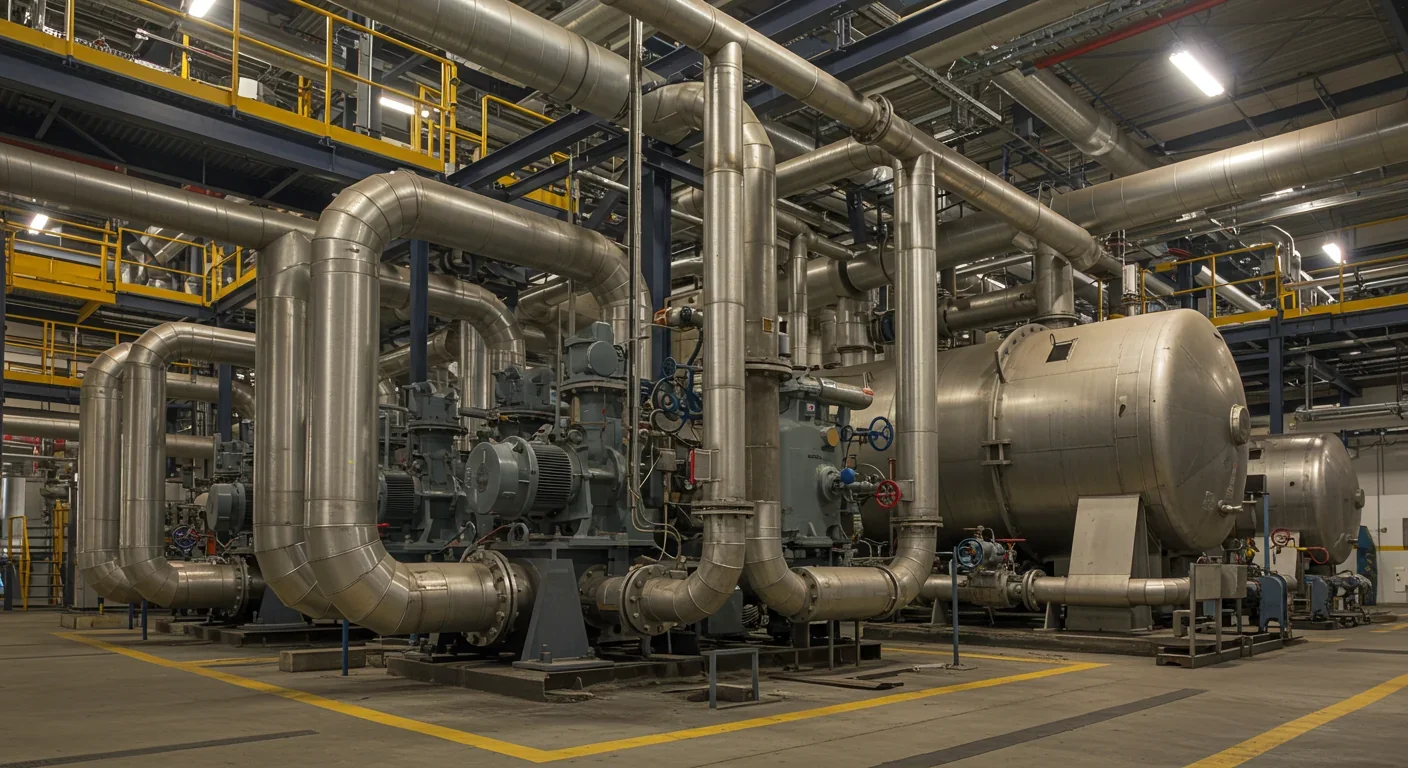
CAES stores excess renewable energy by compressing air in underground caverns, then releases it through turbines during peak demand. New advanced adiabatic systems achieve 70%+ efficiency, making this decades-old technology suddenly competitive for long-duration grid storage.

Human children evolved to be raised by multiple caregivers—grandparents, siblings, and community members—not just two parents. Research shows alloparenting reduces parental burnout, improves child development, and is the biological norm across cultures.

Soft corals have weaponized their symbiotic algae to produce potent chemical defenses, creating compounds with revolutionary pharmaceutical potential while reshaping our understanding of marine ecosystems facing climate change.

Generation Z is the first cohort to come of age amid a polycrisis - interconnected global failures spanning climate, economy, democracy, and health. This cascading reality is fundamentally reshaping how young people think, plan their lives, and organize for change.

Zero-trust security eliminates implicit network trust by requiring continuous verification of every access request. Organizations are rapidly adopting this architecture to address cloud computing, remote work, and sophisticated threats that rendered perimeter defenses obsolete.